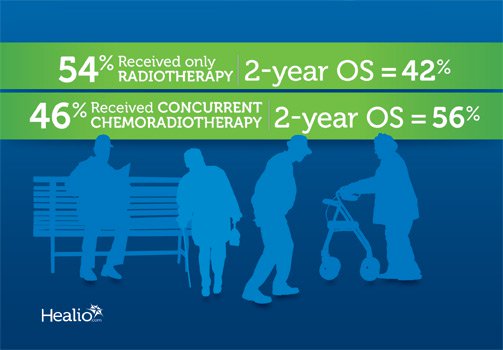Concurrent chemoradiotherapy extends OS for bladder cancer in elderly patients
Concurrent chemoradiotherapy lengthened OS among elderly patients with muscle-invasive bladder cancer compared with radiotherapy alone, according to results from a retrospective study.
“In the United States, patients with muscle-invasive bladder cancer most often are treated with radical cystectomy with or without neoadjuvant or adjuvant chemotherapy, but bladder-preserving concurrent chemoradiotherapy after maximal transurethral resection of bladder tumor or trimodality therapy remains an alternative treatment with equivalent long-term disease control and OS for well-selected patients,” Abhishek A. Solanki, MD, MS, assistant professor of radiation oncology at the Stritch School of Medicine, Loyola University, Chicago, and colleagues wrote. “Using data from the U.S. Census [Bureau], analysis of the growth of 10-year age groups demonstrated that individuals aged 85 years to 94 years experienced the fastest growth between 2000 and 2010. Simultaneously, the use of curative treatment for muscle-invasive bladder cancer in the elderly population appears to be underused.”
The researchers identified 1,369 patients in the National Cancer Data Base aged 80 years or older (median age, 84 years) who received either radiotherapy or concurrent chemoradiotherapy for cT2-T4, NO-3, MO transitional cell muscle-invasive bladder cancer from 2004 through 2013. Median follow-up was 21 months.
In total, 739 patients (54%) underwent radiotherapy alone, while 630 (46%) underwent concurrent chemoradiotherapy.
Patients achieved a 48% OS rate at 2 years. Patients who underwent concurrent chemoradiotherapy showed superior OS (56% vs. 42%; P < .0001).
Multivariate analysis showed an association between concurrent chemoradiotherapy and improved OS (HR = 0.74; 95% CI, 0.65-0.84), as well as a higher dose of radiotherapy (HR = 0.78; 95% CI, 0.67-0.9). Patients with T4 disease had shorter OS (HR = 1.42; 95% CI, 1.15-1.76). The OS benefit conferred by chemoradiotherapy remained after 1-to-1 propensity score matching (HR = 0.77; 95% CI, 0.67-0.9).
“The results of the current study demonstrate that concurrent chemoradiotherapy is associated with improved OS compared with the use of radiotherapy alone in elderly patients with muscle-invasive bladder cancer,” the researchers wrote. “Although a randomized trial in this specific population would be the optimal approach for establishing causality, this is unlikely to be conducted and, thus, the results of the current study support that concurrent chemoradiotherapy should be considered for this group of patients.” – by Andy Polhamus
Disclosure: The researchers report no relevant financial disclosures.

